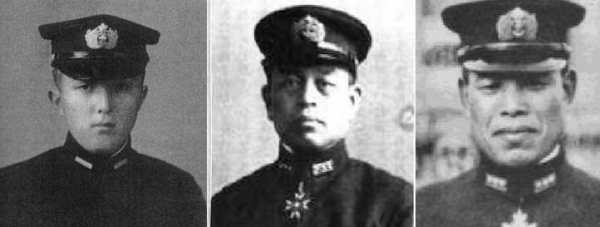| Yamato and Musashi Internet Photo Archive | « previous | index | next » |
|
Ensign Yoshida; Rear Admiral Ariga; Vice-Admiral Ito
Left-to-right:
1. Ensign Yoshida (author of "Requiem for Battleship Yamato") 2. Rear Admiral Ariga, Captain of the Yamato 3. Vice-Admiral Ito, Commander of the Yamato "Special Attack Force", Operation Ten'ichigo, 6-7 April, 1945. A FEW RANDOM THOUGHTS ON YAMATO - PART II: To understand the mystique of the Yamato, you must first learn a few little known facts about the significance of this great ship. Yes, many people know that she was the largest battleship ever constructed - 73,000 tons fully loaded, 25,000 tons of which was armor plating. She was 40 percent larger than the US Iowa-Class battleships. She boasted the biggest guns ever mounted on a ship - nine 18.1" guns mounted in three enormous turrets, two forward, one aft. Each turret weighed 3000 tons, or more than the average WW2 destroyer. In addition, she boasted six 6" secondary guns (which would have been the main battery on most WW2 cruisers), twenty-four 5" anti-aircraft guns, and, by April 1945, an incredible total of 52 three-barrel .25mm anti-aircraft machine guns, 8 single barrel mounts of .25mm anti-aircraft machine guns, and an additional 2 mounts of two-barreled 13 mm 'pea-shooters' located about halfway up the main tower of the front superstructure. Yet all of this armament was virtually useless in the face of a 400-plane assault by the US Navy. So why the Japanese national obsession with the Yamato (to say nothing of the interest the ship generates in the rest of the world)? Well, this is where it gets interesting. You see, as Richard H. Minear pointed out in his translator's introduction to Yoshida Mitsuru's classic "Requiem for Battleship Yamato", "Yamato's mystique was especially strong, in part because Yamato is the poetic name for Japan...Long before the twentieth century the term Yamato evoked among Japanese the emotions captured for Americans in such phrases as 'America the Beautiful' and 'Columbia, the gem of the ocean.'..But battleship Yamato served also as a metaphor: the end of the battleship Yamato, the end of the Japanese empire." |
